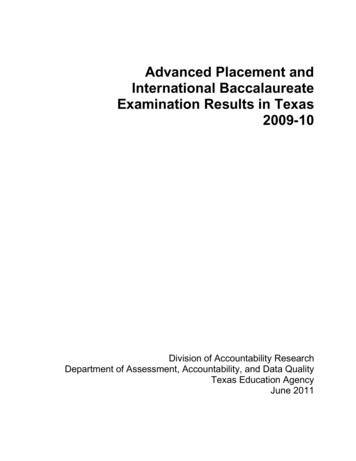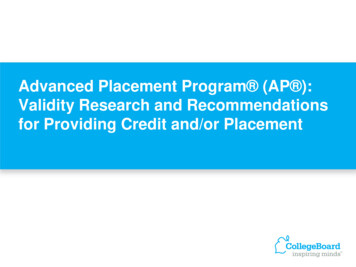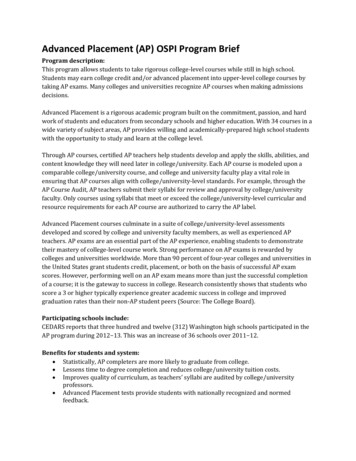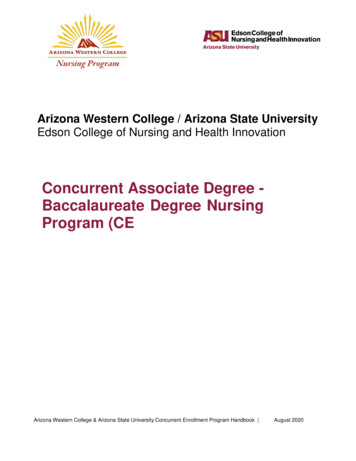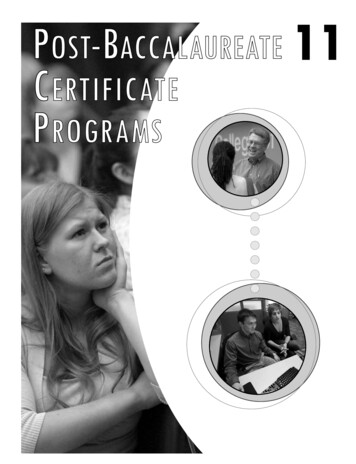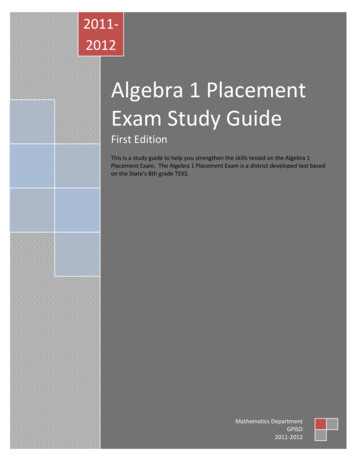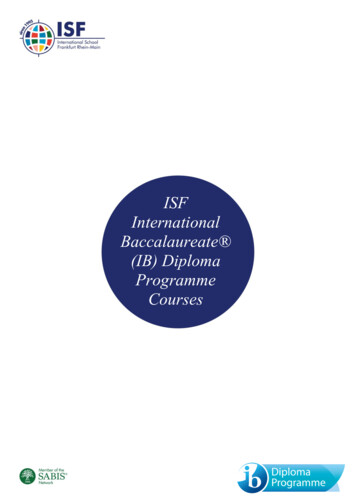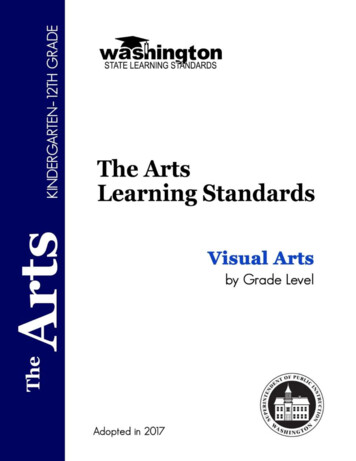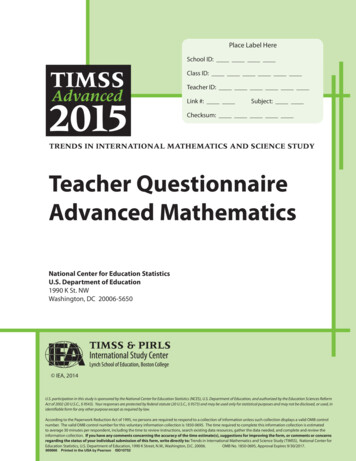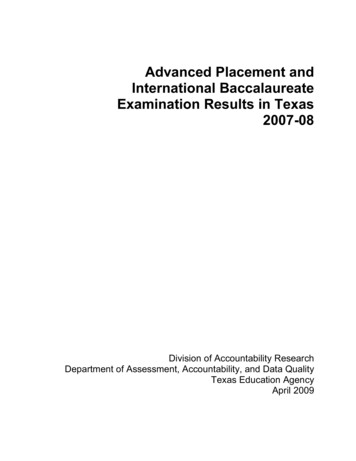
Transcription
Advanced Placement andInternational BaccalaureateExamination Results in Texas2007-08Division of Accountability ResearchDepartment of Assessment, Accountability, and Data QualityTexas Education AgencyApril 2009
Advanced Placement andInternational BaccalaureateExamination Results in Texas2007-08Project StaffRandy GesnShawn ThomasEditorial StaffCristina EverettRichard KallusAmanda CallinanDivision of Accountability ResearchDepartment of Assessment, Accountability, and Data QualityTexas Education AgencyApril 2009
Texas Education AgencyRobert Scott, Commissioner of EducationLizzette Reynolds, Deputy Commissioner for Statewide Policy and ProgramsDepartment of Assessment, Accountability, and Data QualityCriss Cloudt, Associate CommissionerOffice of Data Development, Analysis, and ResearchPatricia Sullivan, Deputy Associate CommissionerDivision of Accountability ResearchLinda Roska, DirectorAdditional AcknowledgmentsSpecial thanks to Carol Young with the College Board for reviewing this report.Citation. Texas Education Agency. (2009). Advanced Placement and International Baccalaureateexamination results in Texas, 2007-08 (Document No. GE09 601 07). Austin, TX: Author.Abstract. This report reviews Advanced Placement (AP) and International Baccalaureate (IB)examination participation and performance in Texas during the 2007-08 school year. Campus-,district-, and state-level examination results for students in Texas public schools are presented, aswell as state-level examination results for students in Texas public and non-public schools combined.The report discusses the use of AP and IB examination results in college admissions and theAcademic Excellence Indicator System. It also provides descriptions and brief histories of the AP andIB programs, along with a brief history of state policy and funding related to the AP and IB programsin Texas.Keywords. Advanced placement, international baccalaureate, credit by examination, testing,incentive, high school, financial need, scores, gifted and talented.Additional copies of this document may be purchased using the order form in the back ofthis publication. Also, the report is available in PDF format on the agency website athttp://www.tea.state.tx.us/research/. Additional information about this report may be obtainedby contacting the Texas Education Agency Division of Accountability Research by phone at(512) 475-3523 or by e-mail at research@tea.state.tx.us.For additional information about AP examinations, contact the College Board Southwestern RegionalOffice at (512) 721-1800 or http://www.collegeboard.com. For information about IB examinations,contact the IB Organization's North American Office at (212) 696-4464 or http://www.ibo.org/.Copyright Notice. The materials are copyrighted and trademarked as the property of the Texas Education Agency (TEA) andmay not be reproduced without the express written permission of TEA, except under the following conditions: (1) Texas public schooldistricts, charter schools, and Education Service Centers may reproduce and use copies of the Materials and Related Materials for thedistricts' and schools' educational use without obtaining permission from TEA; (2) residents of the state of Texas may reproduce and usecopies of the Materials and Related Materials for individual personal use only without obtaining written permission of TEA; (3) any portionreproduced must be reproduced in its entirety and remain unedited, unaltered and unchanged in any way; and (4) no monetary charge can bemade for the reproduced materials or any document containing them; however, a reasonable charge to cover only the cost of reproductionand distribution may be charged. Private entities or persons located in Texas that are not Texas public school districts, Texas EducationService Centers, or Texas charter schools or any entity, whether public or private, educational or non-educational, located outside the stateof Texas MUST obtain written approval from TEA and will be required to enter into a license agreement that may involve the payment of alicensing fee or a royalty. For information contact: Office of Copyrights, Trademarks, License Agreements, and Royalties, Texas EducationAgency, 1701 N. Congress Ave., Austin, TX 78701-1494; phone 512-463-9270 or 512-936-6060; email: copyrights@tea.state.tx.us.Advanced Placement Program, AP, Pre-AP, AP Central, Thinking Maps, AP Vertical Teams, SAT, and PSAT/NMSQT are eitherregistered trademarks or trademarks of the College Board in the U.S.A. or other countries.iiAdvanced Placement and International Baccalaureate Examination Results in Texas, 2007-08
ContentsOverview . 1Section One: Highlights . 3Results for Texas Public Schools. 4Comparative Results for Texas, Other States, and the United States . 6Section Two: Advanced Placement and International Baccalaureate Programs . 7Introduction. 8History . 10Courses. 12Examinations . 14Student and School Fees . 17Section Three: Policy Related to Access to Advanced Placement and International BaccalaureatePrograms. 19College Board and International Baccalaureate Organization Policy. 20State Policy . 20Federal Policy . 23Section Four: Policy Related to Uses of Advanced Placement and International BaccalaureateExamination Results. 25Texas College Admissions Policy . 26Academic Excellence Indicator System Measures . 26Section Five: Data Sources and Reporting of Scores . 29Data Sources . 30Reporting of Scores . 30Section Six: Results for Texas Public Schools. 33Advanced Placement and International Baccalaureate Combined Participation andPerformance . 34Advanced Placement Participation and Performance . 36International Baccalaureate Participation and Performance . 40Qualification for College Credit . 41Examinee Population Profile . 42Relationship Between Advanced Course Participation and Advanced PlacementExamination Participation and Performance. 43Section Seven: Results for Texas and the United States . 47Introduction. 48Advanced Placement Examination Trends . 48Advanced Placement and International Baccalaureate Examination Results in Texas, 2007-08iii
Advanced Placement Examinee Profile .49Advanced Placement Examination Profile .50Appendix A. Supplemental Tables .51Appendix B. Advanced Placement and International Baccalaureate Examination Results, byDistrict and Campus, Texas Public Schools, 2007-08 .97Notes on Appendix B .176Appendix C. Advanced Placement and International Baccalaureate Examination Participationand Performance, by District Characteristic, Texas Public Schools, 2007-08.177Notes on Appendix C .191References.197List of TablesTable 1.Description of Scores in Advanced Placement (AP) and InternationalBaccalaureate (IB) Examination Grading Scales .15Table 2.Advanced Placement (AP) Examination Participation and Performance, Grades 11and 12, Texas Public Schools, 2007-08 .38Table 3.Advanced Placement (AP) Examination Participation and Performance, Grades 9and 10, Texas Public Schools, 2007-08 .39Table 4.International Baccalaureate (IB) Examination Participation and Performance,Grades 11 and 12, Texas Public Schools, 2007-08.41Table 5.Texas Public Schools With Grades 9-12 Advanced Placement (AP) Courses andExaminations, 1992-93 Through 2007-08 .44Table 6.Advanced Placement (AP) Examination Trends, Texas and the United States,1986-87 Through 2007-08 .49Table 7.Advanced Placement (AP) Examinees, by Grade Level, Gender, and Ethnicity,for Texas and the United States, 2007-08 .50Table A-1.Advanced Placement (AP) Examinations, Texas Public School Courses, andMinimum Recommended College Credit Hours for AP Examination Scoresof 3 or Above, 2007-08 .52Table A-2.Advanced Placement (AP)/International Baccalaureate (IB) Incentives, TexasPublic Schools, Through the 2008-2009 Biennium .54Table A-3.Participation and Performance on Advanced Placement (AP) and InternationalBaccalaureate (IB) Examinations Combined, Grades 11 and 12, Texas PublicSchools, 1996-97 Through 2007-08.55Table A-4.Advanced Placement (AP) Examination Participation and Performance, Grades 11and 12, Texas Public Schools, 1994-95 Through 2007-08 .59Table A-5.Advanced Placement (AP) Examinations and Performance, by Subject and Grade,Texas Public Schools, 2007-08.64ivAdvanced Placement and International Baccalaureate Examination Results in Texas, 2007-08
Table A-6.International Baccalaureate (IB) Examination Participation and Performance,Grades 11 and 12, Texas Public Schools, 1994-95 Through 2007-08 . 71Table A-7.International Baccalaureate (IB) Examinations and Performance, by Subject,Texas Public Schools, 2007-08 . 76Table A-8.Students Qualifying for College Credit Based on Advanced Placement (AP) orInternational Baccalaureate (IB) Examination Performance, Grades 11 and 12,Texas Public Schools, 1996-97 Through 2007-08 . 80Table A-9.Advanced Course Completions, Grades 9-12, Texas Public Schools, 1994-95Through 2007-08 . 83Table A-10. Advanced Placement (AP) Examinees Completing Advanced Courses,Grades 9-12, Texas Public Schools, 1994-95 Through 2007-08. 85Table A-11. Advanced Course Completers Taking Advanced Placement (AP) Examinations,Grades 9-12, Texas Public Schools, 1994-95 Through 2007-08. 86Table A-12. Correspondence Between Advanced Placement (AP) Examinations and APCourses Completed, Grades 9-12, Texas Public Schools, 1992-93 Through2007-08. 88Table A-13. Correspondence Between Advanced Placement (AP) Examination Scores andAP Courses Completed, Grades 9-12, Texas Public Schools, 2003-04 Through2007-08. 89Table A-14. Correspondence Between Advanced Placement (AP) Examination Mean Scoresand AP Courses Completed, Grades 9-12, by Subject, Texas Public Schools,2007-08. 90Table A-15. Advanced Placement (AP) Examination Results, Grades 11 and 12, by State andfor the United States, 2007-08. 92Table A-16. Advanced Placement (AP) Examinations and Scores, by Subject, Texas and theUnited States, 2007-08 . 94Table B-1.Advanced Placement (AP) Examination Results, by District and Campus, TexasPublic Schools, 2007-08. 99Table B-2.International Baccalaureate (IB) Examination Results, by District and Campus,Texas Public Schools, 2007-08 . 169Table B-3.Combined Advanced Placement (AP) and International Baccalaureate (IB)Examination Results, by District and Campus, Texas Public Schools, 2007-08. 173Table C-1.Advanced Placement (AP) Examination Participation and Performance, byDistrict Characteristic, Texas Public Schools, 2007-08 . 179Table C-2.International Baccalaureate (IB) Examination Participation and Performance, byDistrict Characteristic, Texas Public Schools, 2007-08 . 185List of FiguresFigure 1.State Funding for Advanced Placement (AP)/International Baccalaureate (IB)Programs, Texas Public Schools, 1996-1997 Biennium Through 2008-2009Biennium . 22Advanced Placement and International Baccalaureate Examination Results in Texas, 2007-08v
Figure 2.Advanced Placement (AP) and International Baccalaureate (IB) ExaminationParticipation, Grades 11 and 12, by Student Group, Texas Public Schools, 1996-97Through 2007-08 .35Figure 3.Advanced Placement (AP) and International Baccalaureate (IB) ExamineePerformance, Grades 11 and 12, by Student Group, Texas Public Schools, 1996-97Through 2007-08 .35Figure 4.Advanced Placement (AP) Examination Participation, Grades 11 and 12, byEthnicity, Texas Public Schools, 1994-95 Through 2007-08 .37Figure 5.Advanced Placement (AP) Examinee Performance, Grades 11 and 12, by Ethnicity,Texas Public Schools, 1994-95 Through 2007-08.37Figure 6.Students Qualifying for College Credit Based on Advanced Placement (AP) orInternational Baccalaureate (IB) Examination Performance, Grades 11 and 12, byEthnicity, Texas Public Schools, 1996-97 Through 2007-08. .42Figure 7.Enrollment and Examinees, Grades 11 and 12, by Ethnicity, Texas Public Schools,2007-08 .43viAdvanced Placement and International Baccalaureate Examination Results in Texas, 2007-08
OverviewAdvanced Placement and International Baccalaureate Examination Results in Texas, 2007-081
OverviewThis report provides 2007-08 Advanced Placement (AP) and International Baccalaureate (IB)examination results for Texas high school students. The report is arranged in seven major sections.The first section presents highlights of AP and IB participation and performance results.The second section includes descriptions and brief histories of the AP and IB programs,information on the courses offered by each program, information on the structure of and developmentof examinations offered by each program, and a summary of student and school fees for participationin each program.The third section includes information on policies and programs related to access to AP and IBprograms and a history of state and federal funding designed to increase access to and participation inAP and IB programs.The fourth section discusses the use of AP and IB examination results in Texas collegeadmissions policy and the use of student AP and IB examination participation and performance as anindicator in the Academic Excellence Indicator System (AEIS).The fifth section presents information on data sources and the reporting of AP and IB scores.The sixth section of the report presents AP and IB participation and performance results forstudents in Texas public schools and provides an in-depth look at advanced course- and examinationtaking patterns of Texas public high school students.The seventh section presents AP results for public and nonpublic high school students in Texas,other states, and the United States.Appendix A provides additional information on AP and IB courses and examinations and ontrends in participation and performance.Appendix B provides AP and IB examination results for each district and campus in Texas.Appendix C provides average AP and IB participation and performance by selected districtcharacteristics.2Advanced Placement and International Baccalaureate Examination Results in Texas, 2007-08
Section One:HighlightsResults for Texas Public SchoolsComparative Results for Texas,Other States, and the United StatesAdvanced Placement and International Baccalaureate Examination Results in Texas, 2007-083
Results for Texas Public SchoolsAdvanced PlacementStatewide Results In the 2007-08 school year, 103,555 Texas public school students in 11th and 12th grade took215,013 Advanced Placement (AP) examinations. From 1994-95 to 2007-08, the percentageof 11th and 12th graders taking AP examinations rose from 6.8 percent to 20.7 percent. The percentage of 11th- and 12th-grade AP examinees scoring in the 3-5 range on at least oneexamination was 49.6 percent in 2007-08. The percentage of examinations with scores in the3-5 range was 45.0 percent. Among 11th- and 12th-grade AP examinees tested in 2007-08, 93.4 percent completedadvanced academic courses during the year. In 2007-08, a total of 689 (64.0%) of the 1,076 Texas public school districts and charterschools with enrollment in Grade 11 and/or Grade 12 had students who took at least one APexamination. In 1992-93, there were only 158 Texas public schools (9.6%) with any of Grades 9through 12 that offered AP courses to students. In 2007-08, 1,124 schools (50.2%) offered atleast one AP course.Participation and Performance by Ethnicity4 Although 11th- and 12th-grade AP participation rates for Hispanics and African Americans inTexas public schools climbed steadily between 1994-95 and 2007-08, only 16.6 percent ofHispanics and 12.0 percent of African Americans took AP examinations in 2007-08. Bycomparison, 24.7 percent of Whites and 47.7 percent of Asian/Pacific Islanders took APexaminations that year. In 2007-08, Hispanic students made up 39.8 percent of public school enrollees in Grades 11and 12 and 32.0 percent of AP examinees. African American students represented13.7 percent of enrollees and 8.0 percent of AP examinees. In contrast, White students madeup 42.5 percent of enrollees and 50.8 percent of AP examinees, and Asian/Pacific Islanderstudents represented 4.0 percent of enrollees and 9.3 percent of AP examinees. In 2007-08 the percentages of Texas public school AP examinees in 11th and 12th gradescoring in the 3-5 range on at least one AP examination decreased over the previous year forAfrican Americans, Asian/Pacific Islanders, and Whites and increased for Hispanics andNative Americans.Advanced Placement and International Baccalaureate Examination Results in Texas, 2007-08
Participation and Performance by Gender From 1994-95 to 2007-08, the participation rate for 11th- and 12th-grade female studentstaking AP examinations increased from 7.5 percent to 22.8 percent; participation for malesincreased from 6.1 percent to 18.4 percent. The percentage of 11th- and 12th-grade female examinees scoring in the 3-5 range on APexaminations was 48.2 percent in 2007-08. The percentage of male examinees scoring in the3-5 range was 51.4 percent.International BaccalaureateStatewide Results In the 2007-08 school year, a total of 2,202 Texas public school students took 6,586International Baccalaureate (IB) examinations. From 1994-95 to 2007-08, the percentage of11th and 12th graders taking IB examinations rose from 0.1 percent to 0.4 percent. In 2007-08, 86.8 percent of IB examinees scored in the 4-7 range. The percentage of AP andIB examinees combined who met the score criteria for either AP or IB (50.1%) was fivetenths of a percentage point higher than for AP alone. In 2007-08, a total of 30 (2.8%) of the 1,076 Texas public school districts and charter schoolswith enrollment in Grade 11 and/or Grade 12 had students who took at least one IBexamination.Participation and Performance by Ethnicity As with AP participation, Asian/Pacific Islander students in Texas public schools had thehighest IB examination participation rate (2.1%) among all ethnic groups in 2007-08. In 2007-08, Native Americans had the highest percentage of Texas IB examinees scoring inthe 4-7 range (100%), followed by Asian/Pacific Islanders (92.2%), Whites (86.9%),Hispanics (83.7%), and African Americans (82.2%). Compared to 2006-07, performancedecreased for African Americans and increased for Asian/Pacific Islanders, Hispanics, andWhites.Participation and Performance by Gender A slightly higher percentage of female (87.9%) than male (85.3%) IB examinees achievedscores in the 4-7 range in 2007-08.Advanced Placement and International Baccalaureate Examination Results in Texas, 2007-085
Comparative Results for Texas, Other States, and the United States6 In 2007-08, a total of 147,241 students in 1,352 Texas public and nonpublic schools took270,466 AP examinations. Texas was 21st among the states in the percentage increase (9.0%)in number of examinees from the previous year. Between 1986-87 and 2007-08, participation in AP examinations increased more rapidly inTexas than in the United States as a whole. In Texas, there were nearly 17 times as manyexaminees in 2007-08 (147,241 examinees) as in 1986-87 (8,792 examinees), whereasnationally, there were nearly six times as many examinees in 2007-08 (1,546,020 examinees)as in 1986-87 (259,222 examinees). The number of Texas public and nonpublic schools participating in AP examinations morethan quadrupled between 1986-87 and 2007-08, from 285 to 1,352. Nationally, the number ofparticipating schools increased from 7,776 to 16,006. In 2007-08, the three AP examinations with the largest numbers of test takers were the samein Texas and the United States: English Language and Composition, United States History,and English Literature and Composition. Compared to the United States, Texas had higher percentages of AP examinations with scoresin the 3-5 range on three examinations: Studio Art Drawing, European History, and ItalianLanguage and Culture.Advanced Placement and International Baccalaureate Examination Results in Texas, 2007-08
Section Two:Advanced Placementand International Baccalaureate ent and School FeesAdvanced Placement and International Baccalaureate Examination Results in Texas, 2007-087
IntroductionProgram DescriptionsThe Advanced Placement (AP) Program and the International Baccalaureate (IB) DiplomaProgramme are advanced academic programs that expose secondary school students to rigorous,college-level academic content. The Advanced Placement Program is a cooperative educationalpartnership between secondary schools and colleges and universities, overseen by the College Board.The International Baccalaureate Diploma Programme is overseen by the International BaccalaureateOrganization (IBO), a nonprofit educational foundation.The Advanced Placement Program offers students the opportunity to take one or more advancedlevel courses and examinations from six academic areas: art and music, English, world languages andcultures, mathematics and computer science, science, and social science and history. Although moststudents participate in AP courses before taking the corresponding examinations, they may take APexaminations without having taken the courses.The International Baccalaureate Diploma Programme is a high school curriculum for studentsages 16-19 that is anchored by three core components: a Theory of Knowledge (TOK) course;Creativity, Action, and Service (CAS) activities; and an extended essay project based on original,independent research. Six academic subject groups build on the core components: Language A1 (firstlanguage), Second Language, Individuals and Societies, Experimental Sciences, Mathematics andComputer Science, and The Arts. Although student participation in the IB courses and examinationsis designed to culminate in attainment of an IB Diploma, students who do not satisfy all requirementsor who choose to take fewer than six subject examinations are awarded certificates for examinationscompleted with acceptable scores (IBO, 2002).Outcomes for StudentsParticipation in AP and IB programs benefits students, teachers, high schools, and the collegesand universities attended by program participants. Students who participate in AP or IB courses aregiven the opportunity to complete college-level coursework while still in high school. Those whoperform well on AP or IB examinations may qualify for college credit and gain advanced placementin college courses when they enroll in institutions of higher education. Students who perform well onAP examinations are eligible for and automatically considered for several types of AP ScholarAwards.Colleges and universities around the world recognize student participation and performance in APand IB courses and examinations. Students participating in the AP Program can earn the AdvancedPlacement International Diploma (APID) for overseas study. To obtain an APID, students attendingschools in the United States must indicate on at least one AP examination answer sheet that scoresshould be sent to a designated university outside the United States. The APID is not a substitute for ahigh school diploma; rather, it is an acknowledgement to universities in other countries that recipients8Advanced Placement and International Baccalaureate Examination Results in Texas, 2007-08
Advanced Placement Scholar AwardsEach year, the College Board offers Advanced Placement (AP) Scholar awards to recognizestudents who demonstrate an ability to perform college level work by obtaining high scores on APexaminations. There are nine different types of AP Scholar awards, each defined by varyingparticipation and performance criteria on AP examinations taken in the current and all previousyears. Although no monetary awards are provided to AP Scholars, the designation isacknowledged on AP grade repo
Table A-4. Advanced Placement (AP) Examination Participation and Performance, Grades 11 and 12, Texas Public Schools, 1994-95 Through 2007-08.59 . Table A-5. Advanced Placement (AP) Examinations and Performance, by Subject and Grade,
